Hello, wonderful readers! It’s your CCL (Cantankerous Cat Lady) here. My printer is broken, and it’s very difficult to get such things repaired in the backwoods of Alaska. So, I have asked Lucinda to join me in writing a post from our experience in which we offer insightful thoughts about “cattitude.”
What are some causes of cattitude, and why do cats see things the way they do? For, as all you folks owned by cats know, these creatures have a very different world view from our own. Lucinda and I will explore some of the differences, and the reasons behind them.
Lucinda: Hopefully , we can enlighten you a bit. First of all, you must consider the differences between our feline background and your own. Many of our cattitudes spring from these differences.
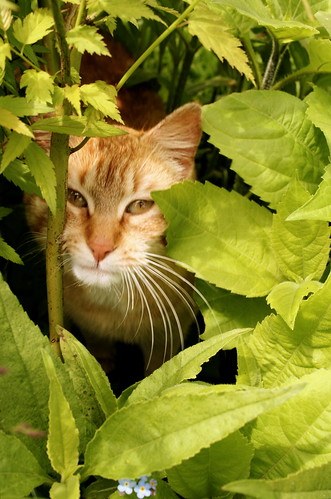
Our world-view was forged from our early beginnings, when we were all wild creatures living on our own, and not with you two-leggeds. We made our way as best we could through an untamed world, full of danger and difficulties. We found just surviving a challenge.
We learned to rely on our instincts, and though our world has changed a great deal now rhat many of us have moved in with you, centuries of wild living created behavior patterns that still direct our lives today.
CCL: Yes, Lucinda, you speak truth. We two-leggeds often forget your earlier ancestors and we fail to realize that you still base your decisions on your lessons learned from those early centuries.
So, let’s take a look at some of your behaviors and see if we can understand them better in the light of the journey you have made.
Let’s start with a very basic cat behavior: that of the purr. This lovely sound occured first between a mother cat and her kittens. From the baby’s earliest hours, the mother’s purr created a vibration in her body that helped the kitten find her nipple so it could feed.
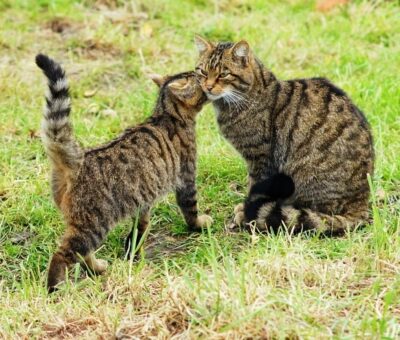
Lucinda: True — and the purr could be used as a way for we cats to socialize with each other — a kind of recognition of species. The purr might not be used as often as with a modern cat, who uses it to express love for her two-legged.
It did, however, serve the purpose for the cat to defuse stress and also to help reduce pain if sick or injured. It became a beneficial tool for an adult cat to help her get through stressful times.
CCL: With early cats, the purr may have just been the recognition of a vibration they could feel within themselves and they found it could benefit them in some ways.
An example from my observations: When Mocha first came to live with me, he had a very soft purr. He’d been born feral, and used his purr as a careful, quiet force, not to express pleasure in the way it can be used when living with a two-legged. Now, after many months of sharing my home, his purr has become loud and lavish.
Lucinda: Cats do not have a verbal language in the manner of a two-legged. Instead, we use all the parts of our bodies to express our thoughts and feelings. Other cats understand us. You two-leggeds have been slow to realize that we cats think with our bodies.
For example, a wagging tail could signal many things. It could tell another cat observer that we experience excitement, annoyance, or fear, simply from the position in which we hold that tail and how we move it.
If the tail has a definite vertical lift, we feel confident or friendly. We might greet other cats we know in such a way. If we flick our tail, it’s usually a sign that we feel agitated or alert. If we switch it back and forth with great energy, better watch out — we start to anger.
One reason a cat in the wild would rely on this body language comes from the fact that he can communicate silently, thus avoiding danger by possibly alerting a predator of his presence.
CCL: I can see a direct connection between a cat’s body movement and his brain. For instance, consider the tail. Carlos seemed to use his tail to indicate puzzlement.
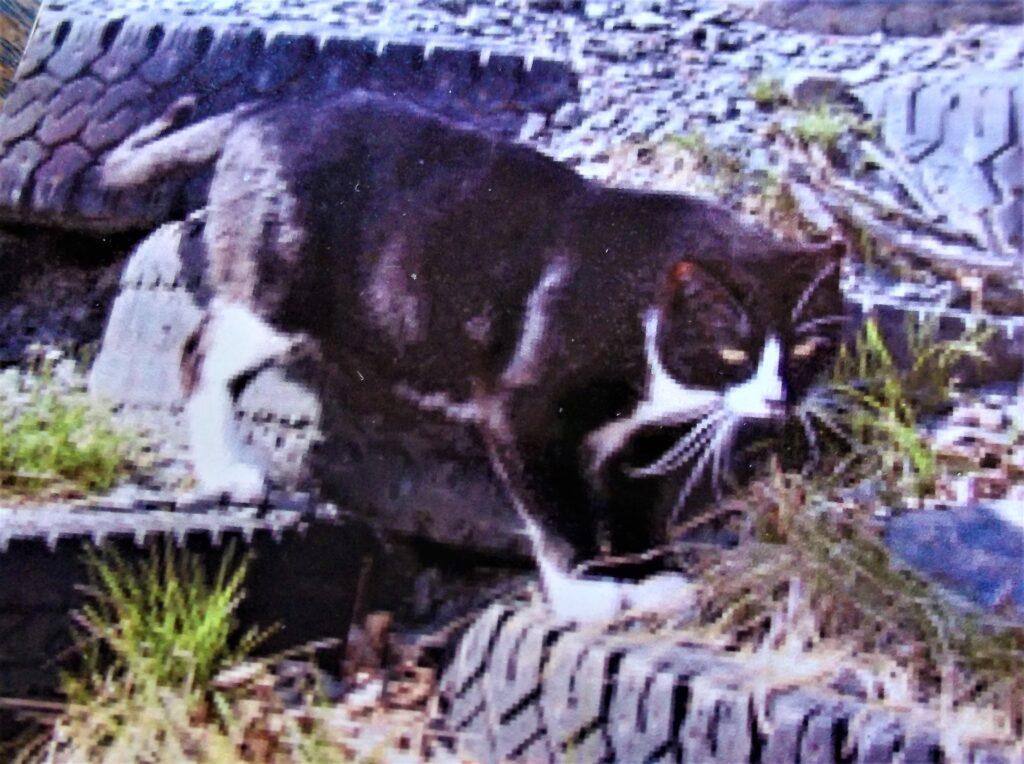
If he tried to work out a solution to a question he had, his tail often waved slowly from side to side, as if he contemplated a decision about something. I considered it a way he puzzled over a decision with more than one choice. “Now, let me see — what would be the best way to proceed?”
Lucinda: Of course. Other parts of the body could show equal expressiveness. One of the easiest for you two-leggeds to interpret occurs when a cat becomes angry or fearful. What does he do? First, he makes himself appear as large as possible.
He arches his back and puffs out his fur. He might advance toward the perceived threat sideways, as that also makes him appear larger. He flattens his ears to the side of his head to make them less vulnerable to attack in case of a confrontation.
CCL: You reminded me of a scene I will never forget. In Bell’s Flats near Kodiak, I stood in the front yard, talking with neighbors. Carlos and Tiger, the neighbor’s cat, stood nearby, close to us two-leggeds.
Tiger, feeling a bit more timid, remained under the porch steps of my house. Carlos stood close to us, in the middle of the yard. Suddenly, the Boxer across the street, wanting to join the group, jumped the fence around his yard and came running toward us.
His path led him between Carlos and the porch steps, cutting off Carlos’s escape route. Tiger, seeing his friend in danger, came instantly to his defence. He came out from under those steps, yowling in his loudest voice, fur extended, back arched, and walking sideways toward that dog.
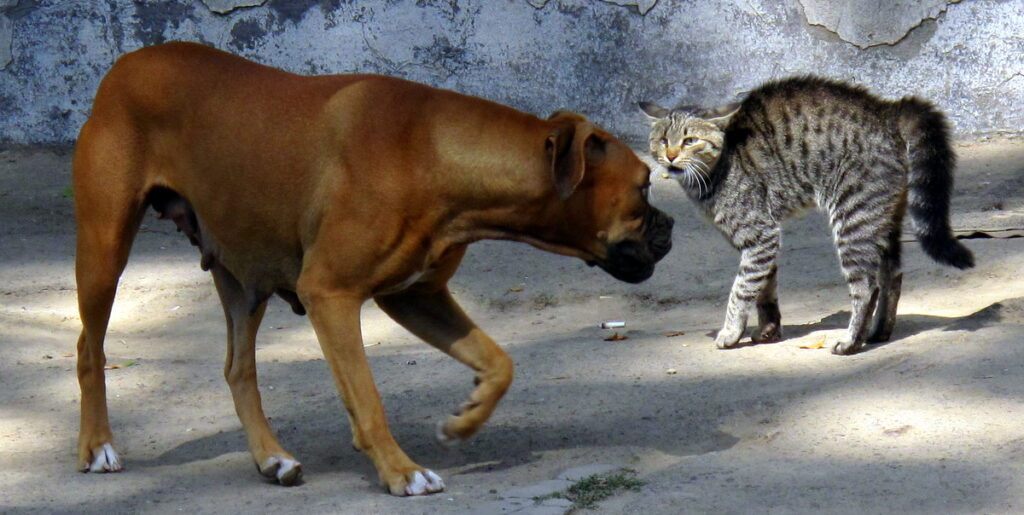
The Boxer stopped in amazement, feeling the waves of anger coming from that cat. The dog’s hesitation gave Carlos a chance to spring for the safe spot underneath the steps, and Tiger ran close behind him.
Side by side, they sang a threatening chorus, designed to give the dog a few nightmares. One of the neighbors collared the dog and returned him to his own yard, where he remained. He must have known he’d gained a reprieve by getting away from those two mad cats.
Lucinda: As you know, cats have a strong feeling about territory, and will defend it at all costs. They let other animals know the boundaries of their particular patch of turf. You two-leggeds can’t detect the signs that we cats leave, but they are there.
We indicate our boundaries by a couple of means. We might mark the outer limits with urine. This smell acts like a fence post. In such a way we notify other creatures that this land belongs to us.
A more subtle way comes from the use of our scent glands, which we carry in several parts of our bodies: Mouth and cheeks, sides of the head and forehead, pads on both our front and back paws, on our sides and tails, behind each ear, and in the anal glands located on either side of the rectum.
As you can see, with all these scent glands, we can mark our territory in many ways by using a number of techniques. You two-leggeds, with your inferior sense of smell, cannot detect these markings, but another animal, and especially another cat, will smell them and know their meaning. It’s a way we cats can show ownership.
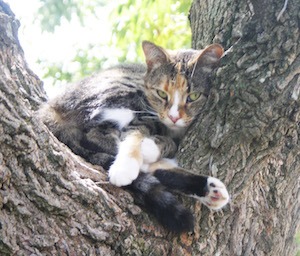
CCL: Yes, and I find it interesting that you cats use those scent glands to mark your two-legged family as well. By rubbing against us with your head, for example, you are saying, “You are mine.” Yes, indeed, if we share a home with a cat, even though he doesn’t hold the property title, he knows that you belong to him.
Lucinda: Another habit of we cats that started in the wild relates to our liking for high places. Here, we feel safer and can observe the world below us.
You can see the reason why cats like to run up trees, and why they have the equipment to do so. Those sharp claws not only serve as weapons, but can take us to a place of safety.
Modern cats still respond to that instinct to find a high place to survey the world.
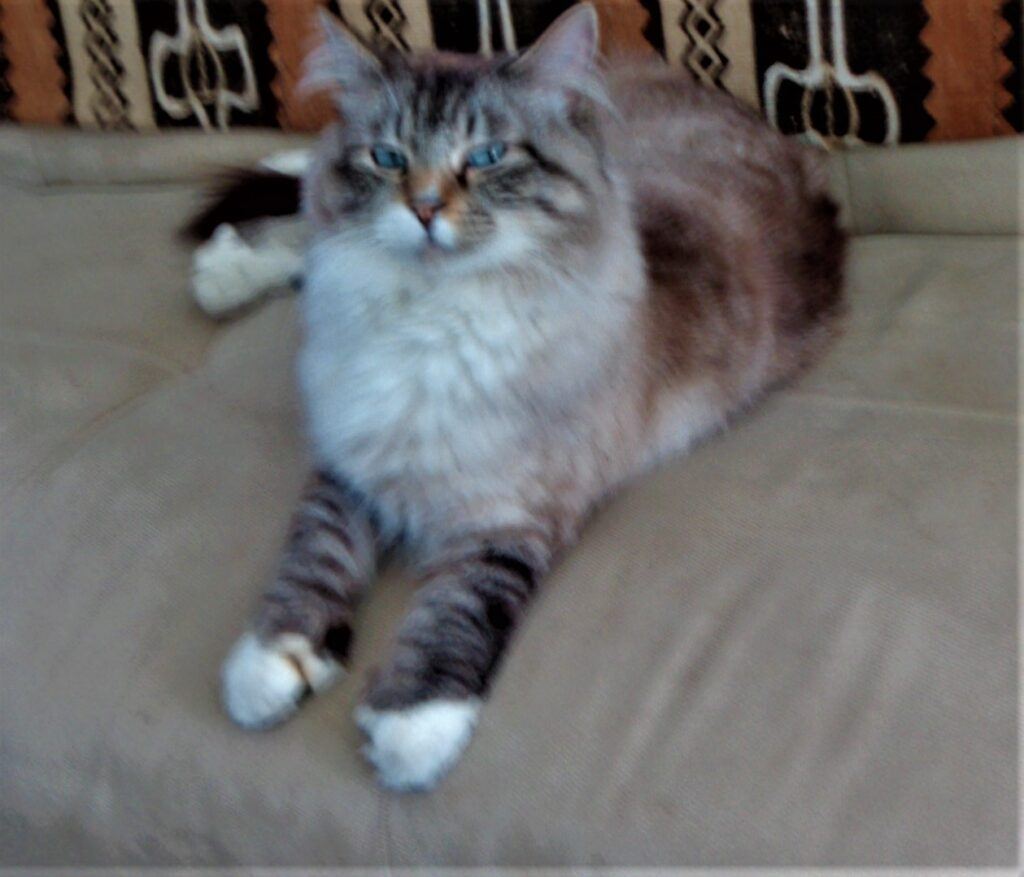
CCL: All my cats have shown this ability and affinity for high places. Just now, I stood in the bathroom and watched Mocha jump from the floor to the top of the sink cabinet, then to the top of the stackable washer-dryer, and then to the storage cubbyhole just under the roof.
That spot is a favorate napping spot for him, as I have a futon stored there, and he likes to nap on it. Depending on how he reclines, I either see nothing of him at all, or just the tops of his ears showing. He surely considers it a safe and cozy napping spot.
Lucinda: We could find many more examples showing why we cats develop our “cattitude,” and they all point to the differences between your species and ours.
CCL: Vive la difference! We are so fortunate to have developed a relationship that allows us to co-exist in spite of our many differences.

